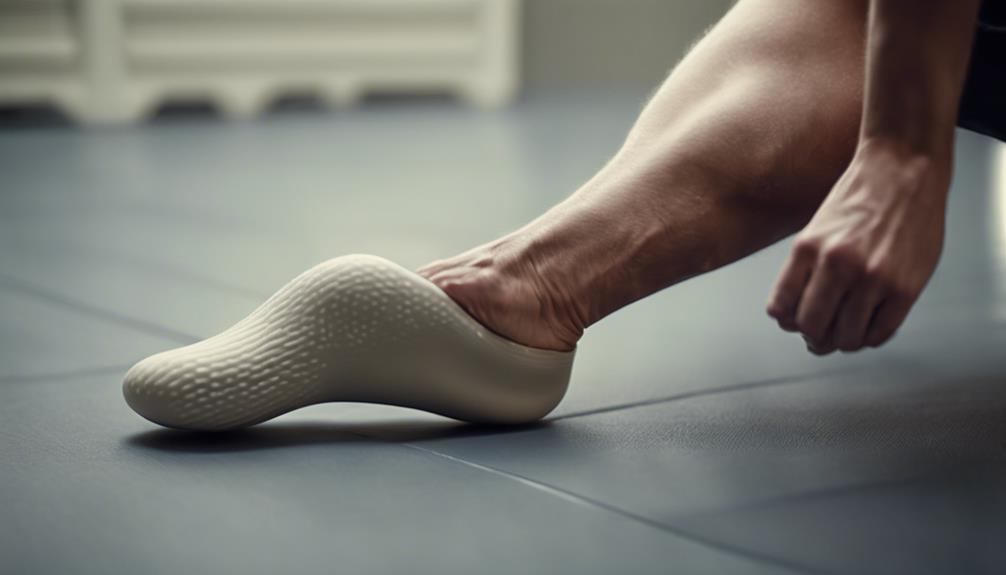I’ve found that proper foot care can really help with plantar fasciitis. Wearing supportive shoes and doing foot stretches can make a big difference. Strengthening exercises like calf raises and toe curls can relieve symptoms. Also, managing weight reduces pressure on the feet. Remember to avoid high-impact activities and choose low-impact exercises. Self-care practices like self-massage and proper arch support are key. You might want to contemplate orthotic inserts for extra relief. Once you get the basics down, foot health maintenance becomes easier. Keep at it, and you’ll notice the difference!
- Understanding Plantar Fasciitis
- Importance of Proper Footwear
- Effective Stretching Techniques
- Strengthening Exercises for Relief
- Managing Weight and Impact Activities
- Incorporating Self-Care Practices
- Role of Supportive Orthotics
- Medical Interventions for Severe Cases
- Long-Term Foot Health Maintenance
- Conclusion
Understanding Plantar Fasciitis

To understand plantar fasciitis, one must grasp the inflammation of the thick ligament on the bottom of the foot. This condition often manifests as pain and discomfort in the heel and arch of the foot, making each step a reminder of the underlying issue. The plantar fascia, a band of tissue connecting the heel bone to the toes, plays an important role in supporting the arch of the foot. When this ligament becomes inflamed due to factors such as tight calf muscles or poor foot structure, it can lead to plantar fasciitis.
Innovative strategies for managing plantar fasciitis include incorporating foot stretches into daily routines to improve flexibility and reduce strain on the plantar fascia. Additionally, strengthening exercises can help stabilize the foot and ankle, reducing the impact of this condition. Proper arch support is essential in footwear to maintain proper alignment and reduce the stress on the plantar fascia during movement. Understanding how the calf muscles interact with the plantar fascia is key to addressing the root causes of discomfort and promoting healing.
Importance of Proper Footwear
Exploring the importance of proper footwear in managing plantar fasciitis reveals the significant role that supportive shoes play in alleviating strain on the plantar fascia. When dealing with plantar fasciitis, choosing the right footwear is essential. Shoes with good arch support can help reduce strain on the plantar fascia, which is important in preventing heel pain and discomfort.
Proper footwear not only provides support but also helps maintain the foot’s natural arch structure, reducing the risk of overstretching the plantar fascia. By opting for shoes with adequate cushioning, impact on the feet is minimized, offering comfort and stability. It’s important to avoid high heels as they can exacerbate plantar fasciitis symptoms by placing additional strain on the fascia and altering the foot’s alignment.
Investing in supportive footwear is a proactive step in managing plantar fasciitis and alleviating associated heel pain. When making shoe choices, prioritize arch support and cushioning to promote proper foot alignment and reduce tension on the plantar fascia. Remember, the right footwear can make a significant difference in your journey towards overcoming plantar fasciitis and maintaining foot health.
Effective Stretching Techniques

Regularly incorporating effective stretching techniques into your routine can greatly help alleviate tension in the plantar fascia and improve foot flexibility. Stretching the calves and the bottom of your feet can be particularly beneficial in reducing discomfort associated with plantar fasciitis. Simple exercises like toe curls and ankle circles not only help in strengthening foot muscles but also enhance flexibility, aiding in the overall care of your feet.
Additionally, avoiding tightly tucked bedsheets that force a pointed foot position during sleep can prevent worsening of plantar fasciitis symptoms.
After exercise sessions, be sure to incorporate calf stretches and foot stretches into your cool-down routine. These stretches can be instrumental in preventing the onset of plantar fasciitis by keeping your feet and calf muscles supple. Even while sitting, you can engage in gentle bending of the toes backward to stretch the bottom of your foot, providing relief from any discomfort you may be experiencing.
Strengthening Exercises for Relief
Shifting from effective stretching techniques, engaging in targeted strengthening exercises is key to relieving plantar fasciitis symptoms and improving foot function. Strengthening exercises play a crucial role in alleviating the pain associated with plantar fasciitis by targeting the muscles that support the arch of the foot. Exercises such as calf raises, toe curls, and ankle circles are particularly beneficial in building strength in the feet and calves, which, in turn, helps reduce tension on the plantar fascia ligament.
By incorporating these targeted exercises into a daily routine, individuals can enhance foot stability and support overall foot health. Stronger muscles in the feet and calves provide better shock absorption and reduce the strain on the plantar fascia, leading to improved foot function and decreased discomfort. Consistency is key, as regularly performing these strengthening exercises can contribute to long-term relief from plantar fasciitis symptoms.
Innovative approaches to foot care involve not only treating symptoms but also addressing the root causes of conditions like plantar fasciitis. Strengthening exercises offer a proactive way to manage foot health, promoting strength and resilience that can help prevent future issues. Embracing these exercises as part of a proactive foot care routine can lead to significant improvements in overall foot function and comfort.
Managing Weight and Impact Activities

Maintaining a healthy weight plays an important role in reducing pressure on the feet and alleviating symptoms of plantar fasciitis. Excess weight can strain the plantar fascia, exacerbating the condition. By shedding extra pounds through a balanced diet and regular exercise, you can help relieve the stress on your feet and promote healing.
Avoiding high-impact activities is essential in managing plantar fasciitis. Running and jumping can put excessive strain on the already sensitive plantar fascia, hindering recovery. Instead, consider low-impact exercises like swimming or cycling. These activities provide cardiovascular benefits without subjecting your feet to the same level of stress.
Selecting supportive footwear is crucial for managing plantar fasciitis and reducing discomfort. Opt for shoes with good arch support and cushioning to alleviate pressure on the plantar fascia. Avoid high heels and shoes with inadequate support, as they can worsen the condition.
Incorporating these strategies into your daily routine, such as maintaining a healthy weight, opting for low-impact exercises, and wearing supportive footwear, can greatly aid in managing plantar fasciitis. By making mindful choices and prioritizing foot health, you can alleviate symptoms and prevent further aggravation of this common foot ailment.
Incorporating Self-Care Practices
To effectively address plantar fasciitis, incorporating self-care practices is key to promoting healing and reducing discomfort in the feet. Stretching exercises play an important role in alleviating plantar fasciitis by targeting the plantar fascia and calf muscles, aiding in improving flexibility and reducing strain on the foot. I find that performing these stretches regularly helps to loosen tight muscles and promote better circulation in the affected area.
In addition to stretching, incorporating massage into my daily routine has been beneficial in reducing tension in the plantar fascia. Using tools like a rolling pin or frozen water bottle for aggressive massage helps to alleviate discomfort and promote healing. I’ve noticed a notable difference in my pain levels after implementing these self-massage techniques consistently.
Furthermore, strengthening exercises are essential for supporting and stabilizing the foot arch structure, which is important in managing plantar fasciitis. By incorporating exercises that target the muscles in the feet and legs, I’ve been able to improve my overall foot strength and reduce the impact of the condition.
Lastly, ensuring proper footwear with good arch support and orthotic inserts is crucial for aiding in the recovery process. Investing in supportive shoes that provide adequate cushioning and stability can greatly reduce discomfort and prevent further aggravation of plantar fasciitis.
Role of Supportive Orthotics

Supportive orthotics play an important role in alleviating plantar fasciitis by providing tailored arch support and correcting foot mechanics to reduce strain on the plantar fascia. These orthotic inserts are customized to fit individual feet, offering targeted relief and promoting proper alignment. By addressing specific foot issues, orthotics help distribute pressure evenly across the foot, which can greatly reduce pain associated with plantar fasciitis.
Orthotic inserts are designed to correct faulty foot mechanics, such as overpronation or supination, which can contribute to the development or exacerbation of plantar fasciitis. By realigning the foot and ankle, orthotics reduce tension on the plantar fascia ligament, allowing it to heal more effectively. Podiatrists, who specialize in foot care, can assess your unique needs and create orthotics tailored to support your feet and aid in the healing process of plantar fasciitis.
Innovative advancements in orthotic technology have led to the development of materials that offer both support and comfort. These modern orthotics are lightweight, durable, and can be seamlessly integrated into your everyday footwear, ensuring that you receive the necessary support without compromising on style or convenience. Choosing the right orthotics, in consultation with a podiatrist, can make a significant difference in alleviating plantar fasciitis and improving your overall foot health.
Medical Interventions for Severe Cases
When facing severe plantar fasciitis, considering medical interventions is essential. Surgical options are a last resort, with procedures like detaching the plantar fascia possibly offering relief.
Injections, shockwave therapy, and other treatments can also help manage pain and promote healing.
Surgery for Last Resort
As a last resort for severe cases of plantar fasciitis that do not respond to conservative treatments, surgery may be considered. While surgery is not common, it can be effective in alleviating the chronic pain associated with plantar fasciitis. The procedure typically involves detaching the plantar fascia from the heel bone to relieve tension and pain. Recovery time post-surgery can vary, ranging from 4 to 12 months. It is important to note that despite surgical intervention, there is a possibility that symptoms may persist. Here is a table outlining key points regarding plantar fasciitis surgery:
| Key Points | Details |
|---|---|
| Surgery Type | Last Resort for Severe Cases |
| Recovery Time | 4 to 12 months |
| Effectiveness | Addressing Chronic Pain, Symptoms may Persist |
Injections for Pain Relief
In severe cases of plantar fasciitis, cortisone injections offer essential pain relief for patients experiencing chronic discomfort. Unlike temporary solutions, such as over-the-counter pain medications, cortisone injections deliver targeted relief directly to the inflamed area, reducing inflammation and providing significant pain relief.
Podiatrists, specialized in foot care, can administer these injections with precision, ensuring maximum effectiveness. By opting for injections, individuals can benefit from a more focused approach to managing the symptoms of plantar fasciitis, allowing them to regain mobility and engage in daily activities with reduced pain.
When combined with other treatments like physical therapy, cortisone injections can play a vital role in alleviating the persistent pain associated with severe cases of plantar fasciitis.
Shockwave Therapy Option
For severe cases of plantar fasciitis, considering shockwave therapy as a non-invasive treatment option can be beneficial. Shockwave therapy utilizes high-energy shockwaves to stimulate healing in the affected area, offering pain reduction and improved function. Studies demonstrate its effectiveness in greatly alleviating plantar fasciitis symptoms.
This innovative approach typically involves multiple sessions over a few weeks to achieve excellent results. By opting for shockwave therapy, patients can explore an alternative to surgery for persistent plantar fasciitis symptoms. Embracing this advanced treatment option showcases a commitment to addressing the condition with cutting-edge solutions while prioritizing non-invasive interventions for enhanced recovery.
Long-Term Foot Health Maintenance
Proper long-term foot health maintenance involves establishing a consistent routine of wearing supportive footwear and engaging in regular stretching exercises. By prioritizing footwear with good arch support, individuals can alleviate the strain on the plantar fascia, reducing the likelihood of developing or exacerbating plantar fasciitis. Incorporating stretching routines that target the plantar fascia and calf muscles helps maintain flexibility and strength in the feet, promoting overall foot health.
Maintaining a healthy weight is also vital for long-term foot health. Excess weight places added stress on the feet, increasing the risk of developing foot conditions such as plantar fasciitis. By adopting a healthy lifestyle that includes regular exercise and a balanced diet, individuals can reduce this burden on their feet and lower the chances of foot-related issues.
Additionally, avoiding high-impact activities and prolonged periods of standing can help prevent worsening symptoms of plantar fasciitis. Being mindful of how the feet are feeling during physical activities and addressing any discomfort promptly can contribute to long-term foot health maintenance. Listening to the body’s signals and providing the necessary care and attention to foot health is key to preventing and managing conditions like plantar fasciitis effectively.
Conclusion
So, remember folks, taking care of your feet is essential in alleviating plantar fasciitis.
It’s not just about wearing fancy shoes or doing some stretches – it’s about showing your feet some love and respect. Because let’s face it, they do a lot for us and they deserve a little pampering every now and then.
So go ahead, treat your feet right and they’ll thank you in the long run.

